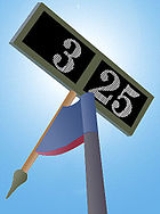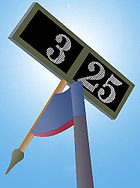
Digital sundial
Encyclopedia
A digital sundial is a clock that indicates the current time with numerals formed by the sunlight striking it. Like a classical sundial
, the device is purely passive and contains no moving parts. It uses no electricity nor other artificial sources of energy.
The digital display changes as the sun advances in its daily course.
, while the other is inspired by fractal
geometry.
. Each socket fiber is connected to a few segments forming the digit corresponding to the position of the sun.
 The theoretical basis for the other construction comes from fractal geometry. For the sake of simplicity we describe a two-dimensional (planar) version.
The theoretical basis for the other construction comes from fractal geometry. For the sake of simplicity we describe a two-dimensional (planar) version.
Let denote a straight line passing through the origin of a Cartesian coordinate system
denote a straight line passing through the origin of a Cartesian coordinate system
and making angle with the x-axis.
with the x-axis.
For any define
define  to be the perpendicular projection of F on the line
to be the perpendicular projection of F on the line  .
.
 ,
,  be a family of any sets such that
be a family of any sets such that  is a measurable set in the plane.
is a measurable set in the plane.
Then there exists a set
such that
Sundial
A sundial is a device that measures time by the position of the Sun. In common designs such as the horizontal sundial, the sun casts a shadow from its style onto a surface marked with lines indicating the hours of the day. The style is the time-telling edge of the gnomon, often a thin rod or a...
, the device is purely passive and contains no moving parts. It uses no electricity nor other artificial sources of energy.
The digital display changes as the sun advances in its daily course.
Technique
There are two basic types of digital sundials. One construction uses optical waveguidesWaveguide (optics)
An optical waveguide is a physical structure that guides electromagnetic waves in the optical spectrum. Common types of optical waveguides include optical fiber and rectangular waveguides....
, while the other is inspired by fractal
Fractal
A fractal has been defined as "a rough or fragmented geometric shape that can be split into parts, each of which is a reduced-size copy of the whole," a property called self-similarity...
geometry.
Optical fiber sundial
Sunlight enters into the device through a slit and moves as the sun advances. The sun's rays shine on ten linearly distributed sockets of optical waveguides that transport the light to a seven-segment displaySeven-segment display
A seven-segment display , or seven-segment indicator, is a form of electronic display device for displaying decimal numerals that is an alternative to the more complex dot-matrix displays...
. Each socket fiber is connected to a few segments forming the digit corresponding to the position of the sun.
Fractal sundial

Let
 denote a straight line passing through the origin of a Cartesian coordinate system
denote a straight line passing through the origin of a Cartesian coordinate systemCartesian coordinate system
A Cartesian coordinate system specifies each point uniquely in a plane by a pair of numerical coordinates, which are the signed distances from the point to two fixed perpendicular directed lines, measured in the same unit of length...
and making angle
 with the x-axis.
with the x-axis.For any
 define
define  to be the perpendicular projection of F on the line
to be the perpendicular projection of F on the line  .
.Theorem
Let ,
,  be a family of any sets such that
be a family of any sets such that  is a measurable set in the plane.
is a measurable set in the plane.Then there exists a set

such that
-
 ;
; - the measure of the set
 is zero for almost all
is zero for almost all 
There exists a set with prescribed projections in almost all directions. This theorem can be generalized to three-dimensional space. For a non-trivial choice of the family , the set F described above is a fractal.
, the set F described above is a fractal.
Application
Theoretically, it is possible to build a set of masks that produce shadows in the form of digits, such that the display changes as the sun moves. This is the fractal sundial.
The theorem was proved in 1987 by Kenneth Falconer. Four years later it was described in Scientific AmericanScientific AmericanScientific American is a popular science magazine. It is notable for its long history of presenting science monthly to an educated but not necessarily scientific public, through its careful attention to the clarity of its text as well as the quality of its specially commissioned color graphics...
by Ian StewartIan Stewart (mathematician)Ian Nicholas Stewart FRS is a professor of mathematics at the University of Warwick, England, and a widely known popular-science and science-fiction writer. He is the first recipient of the , awarded jointly by the LMS and the IMA for his work on promoting mathematics.-Biography:Stewart was born...
. The first prototype of the device was constructed in 1994. In 1998 for the first time a fractal sundial was installed in a public place (Genk, Belgium). There exist window and tabletop versions as well.

